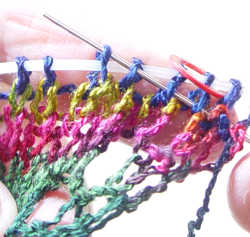In Part 1 of Striving for Perfect Results, we covered some tips on PREVENTING mistakes (or at least minimize the chances of them happening).
With all my best attempts at preventing mistakes, I am only human. The reality of life is that lace knitting mistakes will happen. Believe me, I’ve had a lot of practice in getting out of jams I put myself into (and still do!). So in Part 2, I am going to share with you a quick look at my arsenal of tips for REMEDY; i.e. correcting, repairing and recovering. I want you to know that it’s possible to deal with mistakes and survive to tell about it, lol.
Getting Back on Track
(or what to do when inevitable mistakes happen)
- Take a breath, stay calm
- Common mistakes and easy remedies
Problem: You have counted the row you just completed and find your stitch count is LESS than it should be because you are missing a yarn over.
Remedy:
Step 1. identify where the yarn over should have been and mark that positionStep 2. as you work the return row, when you come to that position, just pick up the running thread in the row below and place the picked up loop on your left-hand needle
(the picked up loop will be a bit tighter than if the yarn over had been made correctly on the original row, but the bit of difference in tension will not be noticeable after the lace has been washed and blocked)Step 3. continue on with the return row, working the picked up loop as the regular yarn over stitch that it should have been
Problem: You have counted the row you just completed and find your stitch count is MORE than it should be because you have an extra yarn over
Remedy:
Step 1. identify the extra yarn over stitch and mark that positionStep 2. as you work the return row, when you come to that position, just drop the loop of the extra yarn over off the left-hand needle
(the area where the extra yarn over was dropped off the needle will looser be than if you had not made the mistake, but the bit of difference in tension will hardly be noticeable after the lace has been washed and blocked)Step 3. continue on with the return row as usual
- The current row is “off” (not enough stitches to complete row; too many …; pattern design is off …)
Step 1: TINK (knit spelled backwards) – i.e. unwork stitches one by one across the row
Step 2: Recheck your stitch count, then proceed
- Pattern is just “not working out” and you can’t figure out why
With narrow lace edgings with relatively few stitches like we’ve been doing, if you have barely gotten much done anyway (e.g. still just working on the first 2 or 3 inches), it’s usually easiest and quickest to just start over rather than stress out trying to find a problem originating multiple rows back. Give it a go again, because maybe you just overlooked or misread something the first time around. (Also see Have Our Eyes Fooled Us.)
- Anticipate calamities (e.g. dropped stitches)
On the other hand, if you are well into already having worked quite a length of lace edging, you certainly don’t want to rip and start over! That is where using a lifeline can be invaluable. It is like “Insurance for Knitters” comes in.
In short, I’ll include the basic steps below. But there is also a longer tutorial for The Lifeline available on my HeartStringsFiberArts.com website that can be helpful for working with any of your lace projects.

Inserting a lifeline
Lifeline Preparation step: Insert a piece of contrasting thread through the stitches of a designated row, e.g. last row of pattern repeat. You will remove these contrast threads after your article is completed.
If/when a mistake shows up —
Step 1: Remove needle and rip back to contrasting thread
Step 2: Insert needle through loop of each stitch (just follow the thread so that the stitches are mounted properly)
Step 3: Recheck your stitch count, then proceed with appropriate row e.g. first row of pattern repeat


 HeartStrings FiberArts
HeartStrings FiberArts Knitting Bits of Lace on Facebook
Knitting Bits of Lace on Facebook Ravelry Store
Ravelry Store
Pingback: Starting the Spring Lace Leaves Scarf | Knit HeartStrings Learn-and-Knit-Alongs
I also do some knitting from a lace designer on yahoo. The patterns are free, and at times do have mistakes. We “test” knit the designs, feed back errors and then the patterns are refined.
Let me be clear that I am offering a free pattern here each month, not for you or anyone else to feel obligated that you are expected to “test” knit it.
Please – if you or someone has a question about one of my patterns, please ask me. I have both email and phone numbers on my patterns as well as website where you can contact me.
I am not infallible (and certainly don’t claim to be, and sometimes computer glitches can occur with the online downloadable stuff), but the intent is to give you and others an enjoyable learning and knitting experience, without stressing that you are dealing with patterns that are riddled with mistakes! OK? Knit on!
This sitemisnwonderful and am ejoying following along. L
I am working on a feather and fan baby blanket. When I am tired I make mistakes on it , and I can’t leave it. I mark the stitch that is the mistake and tink back to it and fix it. Then I reknit the rows I un-knitted.
Sometimes when “■Pattern is just “not working out” and you can’t figure out why”, it’s because… I hate to say it, but… the directions are wrong. Check the internet to see if a correction has been provided. Vogue Knitting is good about doing this. Some books also have corrections available at the publisher’s web-site.